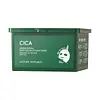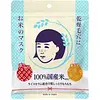What's inside
What's inside
 Key Ingredients
Key Ingredients

 Benefits
Benefits

 Concerns
Concerns

 Ingredients Side-by-side
Ingredients Side-by-side

Water
Skin ConditioningDipropylene Glycol
HumectantGlycerin
HumectantBetaine
HumectantHydroxyacetophenone
AntioxidantPolyglyceryl-10 Laurate
Skin ConditioningButylene Glycol
HumectantEthylhexylglycerin
Skin ConditioningAllantoin
Skin Conditioning1,2-Hexanediol
Skin ConditioningArginine
MaskingXanthan Gum
EmulsifyingCarbomer
Emulsion StabilisingSodium Hyaluronate
HumectantCentella Asiatica Extract
CleansingDiethylhexyl Sodium Sulfosuccinate
CleansingPropolis Extract
Skin ConditioningOctyldodecanol
EmollientDipotassium Glycyrrhizate
HumectantCarum Carvi Seed Oil
MaskingHydrogenated Lecithin
EmulsifyingCeramide NP
Skin ConditioningHydrogenated Phosphatidylcholine
EmulsifyingCaprylic/Capric Triglyceride
MaskingPotassium Hyaluronate
Skin ConditioningSodium Hyaluronate Crosspolymer
HumectantHyaluronic Acid
HumectantHydroxypropyltrimonium Hyaluronate
Hydrolyzed Hyaluronic Acid
HumectantHydrolyzed Sodium Hyaluronate
Skin ConditioningSucrose Stearate
EmollientAsiaticoside
AntioxidantAsiatic Acid
Skin ConditioningMadecassic Acid
Skin ConditioningCaprylyl Glycol
EmollientCholesterol
EmollientMadecassoside
AntioxidantSodium Acetylated Hyaluronate
HumectantAcetyl Tetrapeptide-5
HumectantAcetyl Hexapeptide-8
HumectantHexapeptide-9
Skin ConditioningOligopeptide-29
AntioxidantOligopeptide-32
AntiseborrhoeicTripeptide-1
Skin ConditioningDisodium EDTA
Parfum
MaskingWater, Dipropylene Glycol, Glycerin, Betaine, Hydroxyacetophenone, Polyglyceryl-10 Laurate, Butylene Glycol, Ethylhexylglycerin, Allantoin, 1,2-Hexanediol, Arginine, Xanthan Gum, Carbomer, Sodium Hyaluronate, Centella Asiatica Extract, Diethylhexyl Sodium Sulfosuccinate, Propolis Extract, Octyldodecanol, Dipotassium Glycyrrhizate, Carum Carvi Seed Oil, Hydrogenated Lecithin, Ceramide NP, Hydrogenated Phosphatidylcholine, Caprylic/Capric Triglyceride, Potassium Hyaluronate, Sodium Hyaluronate Crosspolymer, Hyaluronic Acid, Hydroxypropyltrimonium Hyaluronate, Hydrolyzed Hyaluronic Acid, Hydrolyzed Sodium Hyaluronate, Sucrose Stearate, Asiaticoside, Asiatic Acid, Madecassic Acid, Caprylyl Glycol, Cholesterol, Madecassoside, Sodium Acetylated Hyaluronate, Acetyl Tetrapeptide-5, Acetyl Hexapeptide-8, Hexapeptide-9, Oligopeptide-29, Oligopeptide-32, Tripeptide-1, Disodium EDTA, Parfum
Water
Skin ConditioningGlycerin
HumectantPropylene Glycol
HumectantAlcohol Denat.
AntimicrobialStyrene/Vp Copolymer
Lactobacillus/Rice Ferment Filtrate
Skin ConditioningOryza Sativa Bran Oil
EmollientHydrolyzed Rice Bran Extract
Skin ConditioningGlycosphingolipids
EmollientGlucosyl Ceramide
Skin ConditioningAlpha-Glucan
HumectantButylene Glycol
HumectantXanthan Gum
EmulsifyingPolysorbate 80
EmulsifyingCitric Acid
BufferingSodium Citrate
BufferingPhenoxyethanol
PreservativeMethylparaben
PreservativeWater, Glycerin, Propylene Glycol, Alcohol Denat., Styrene/Vp Copolymer, Lactobacillus/Rice Ferment Filtrate, Oryza Sativa Bran Oil, Hydrolyzed Rice Bran Extract, Glycosphingolipids, Glucosyl Ceramide, Alpha-Glucan, Butylene Glycol, Xanthan Gum, Polysorbate 80, Citric Acid, Sodium Citrate, Phenoxyethanol, Methylparaben
 Reviews
Reviews

Ingredients Explained
These ingredients are found in both products.
Ingredients higher up in an ingredient list are typically present in a larger amount.
Butylene Glycol (or BG) is used within cosmetic products for a few different reasons:
Overall, Butylene Glycol is a safe and well-rounded ingredient that works well with other ingredients.
Though this ingredient works well with most skin types, some people with sensitive skin may experience a reaction such as allergic rashes, closed comedones, or itchiness.
Learn more about Butylene GlycolGlycerin is already naturally found in your skin. It helps moisturize and protect your skin.
A study from 2016 found glycerin to be more effective as a humectant than AHAs and hyaluronic acid.
As a humectant, it helps the skin stay hydrated by pulling moisture to your skin. The low molecular weight of glycerin allows it to pull moisture into the deeper layers of your skin.
Hydrated skin improves your skin barrier; Your skin barrier helps protect against irritants and bacteria.
Glycerin has also been found to have antimicrobial and antiviral properties. Due to these properties, glycerin is often used in wound and burn treatments.
In cosmetics, glycerin is usually derived from plants such as soybean or palm. However, it can also be sourced from animals, such as tallow or animal fat.
This ingredient is organic, colorless, odorless, and non-toxic.
Glycerin is the name for this ingredient in American English. British English uses Glycerol/Glycerine.
Learn more about GlycerinWater. It's the most common cosmetic ingredient of all. You'll usually see it at the top of ingredient lists, meaning that it makes up the largest part of the product.
So why is it so popular? Water most often acts as a solvent - this means that it helps dissolve other ingredients into the formulation.
You'll also recognize water as that liquid we all need to stay alive. If you see this, drink a glass of water. Stay hydrated!
Learn more about WaterXanthan gum is used as a stabilizer and thickener within cosmetic products. It helps give products a sticky, thick feeling - preventing them from being too runny.
On the technical side of things, xanthan gum is a polysaccharide - a combination consisting of multiple sugar molecules bonded together.
Xanthan gum is a pretty common and great ingredient. It is a natural, non-toxic, non-irritating ingredient that is also commonly used in food products.
Learn more about Xanthan Gum